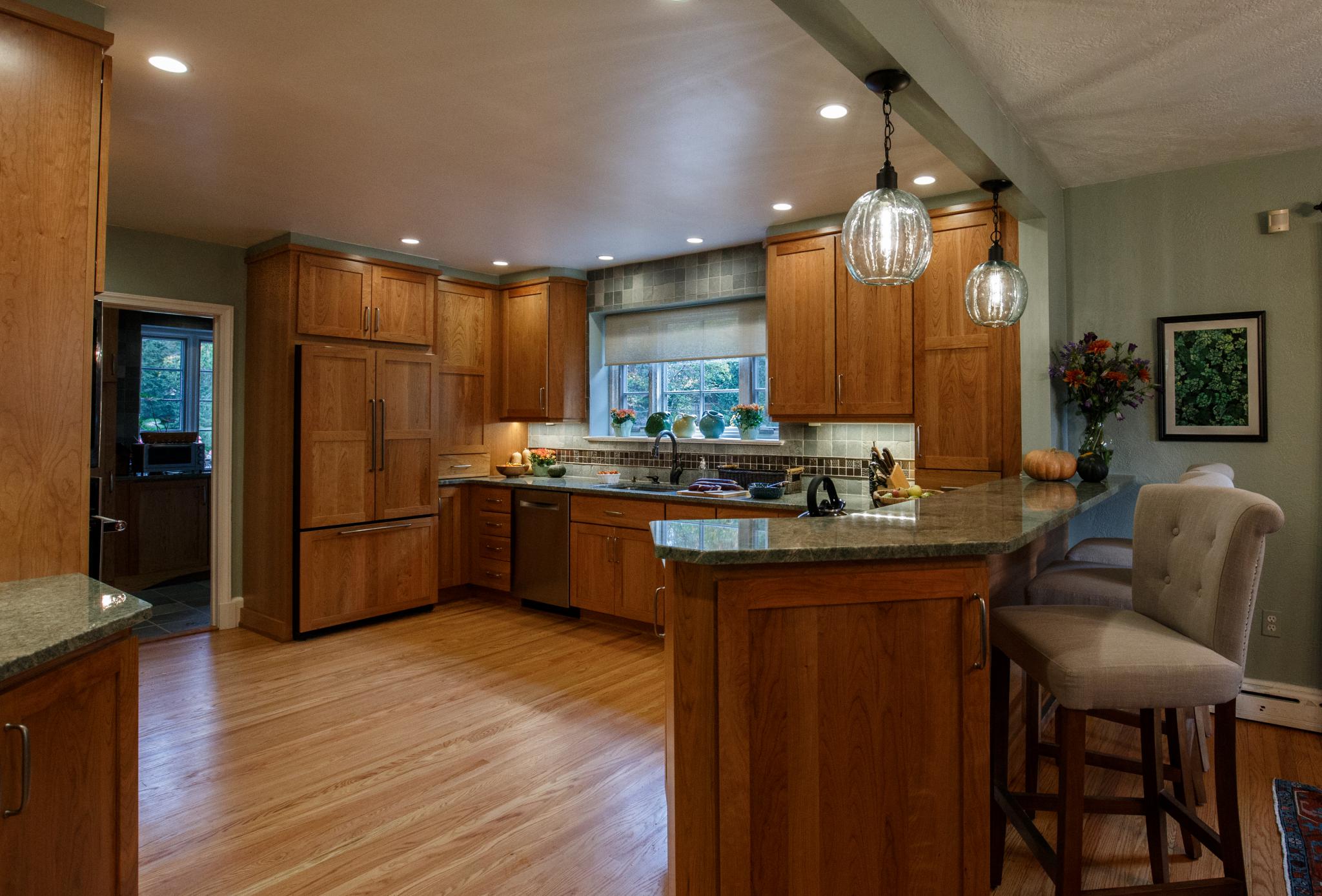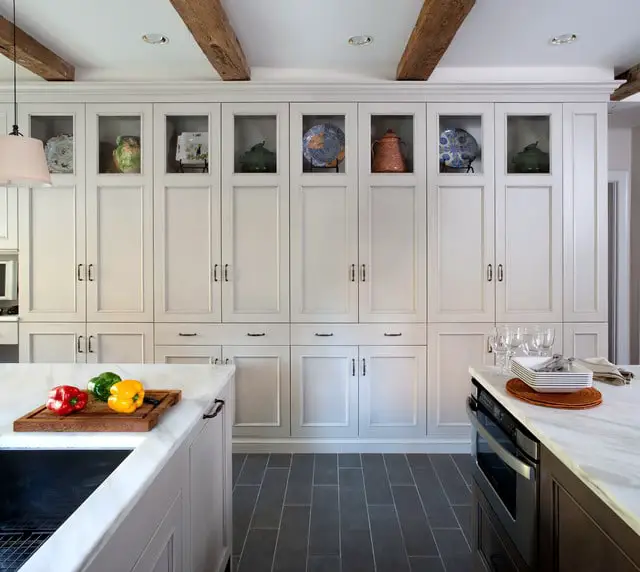How to Build a Floor to Ceiling Kitchen Cabinet
When it comes to kitchen remodeling, one of the most popular items to add is floor-to-ceiling cabinets. Not only do they provide added storage space, but they also give the room a more polished look. If you’re considering adding this type of cabinet to your kitchen, here’s what you need to know in order to get started.
The first step is to determine where you want the cabinets to go. Keep in mind that they will need to be anchored into studs in order for them to be secure. Once you have a general idea of where they will go, measure the area and start planning out your design.
You’ll need to consider things like door and drawer placement as well as shelving options. Once you have a plan in place, it’s time to start gathering materials. Most floor-to-ceiling cabinets are made from wood, so you’ll need lumber, plywood, trim, molding, and hardware like hinges and handles.
You may also want to add extras like crown molding or glass doors depending on your overall design scheme. With all of your materials gathered, it’s time to start building! Begin by assembling the frame of the cabinet using either screws or nails (depending on what type of wood you’re working with).
Once the frame is together, add plywood or particleboard panels for the sides and doors. Finish up by adding trim around all edges and painting or staining everything according to your preferences.
- Cut out two pieces of plywood that will serve as the sides of the cabinet using a circular saw
- The pieces should be cut to the desired height of the cabinet
- Drill four holes into each piece of plywood, two near the top and two near the bottom
- These holes will be used to attach the plywood pieces to vertical supports
- Cut four vertical supports out of 2×4 lumber using a Sawzall or handsaw
- The supports should be cut to the same height as the pieces of plywood
- Attach the vertical supports to the wall studs using 3″ screws and a drill/driver
- Place two screws into each stud, one at the top and one at the bottom of each support
- Slide the pieces of plywood up against the vertical supports and screw them into place using 2″ screws and a drill/driver countersink bit
- Space out the screws evenly along both sides of each piece of plywood
How Do You Attach Kitchen Cabinets to the Ceiling?
In most cases, kitchen cabinets are attached to the ceiling with screws. In some instances, however, nails may also be used. The type of fastener used will depend on the material of the cabinet and the ceiling.
If you’re working with wood cabinets and a drywall ceiling, for example, you’ll want to use screws rather than nails so that the connection is strong enough to support the weight of the cabinets. If your kitchen has a drop ceiling, however, you may be able to get away with using nails instead since there’s less weight to worry about. When attaching your cabinets to the ceiling, it’s important to make sure that you’re using appropriate hardware.
If possible, try to find screws or nails that are specifically designed for use in ceilings. This will help ensure a secure connection between the two surfaces. Once you have your hardware sorted out, simply drive the screws or nails into place through the holes in the back of the cabinets.
Be careful not to over-tighten them, as this could cause damage to both surfaces. With proper installation, your kitchen cabinets should be securely attached to the ceiling and ready for use!

How Deep are Floor to Ceiling Cabinets?
Assuming you are talking about kitchen cabinets, the average depth of floor-to-ceiling cabinets is 24 inches. However, this can vary depending on the style and design of the kitchen as well as the size of the room. For example, if you have a small kitchen, you may want to opt for shallower cabinets to make the space feel bigger and more open.
On the other hand, if you have a large kitchen with plenty of counter space, you may want to choose deeper cabinets to maximize storage capacity. Ultimately, it is up to you to decide what cabinet depth works best for your needs and aesthetic preferences.
Can Kitchen Cabinets Be Mounted to the Ceiling?
The answer is yes, kitchen cabinets can be mounted to the ceiling. There are a few things you need to take into consideration when doing this, such as the height of your ceilings and the weight of the cabinets. You will also need to make sure that the cabinets are properly secured to the ceiling so that they don’t come crashing down.
If done correctly, mounting kitchen cabinets to the ceiling can give your kitchen an updated and stylish look.
Why Do Cabinets Not Go to Ceiling?
One of the most common questions we get here at Cabinet DIY is why cabinets don’t go to the ceiling. There are actually a few reasons for this! The first reason is simply aesthetics.
A lot of people feel that having cabinets that go all the way up to the ceiling can look a bit cluttered and busy. It can also make a space feel smaller than it actually is. Another reason is function.
Cabinets that go all the way up to the ceiling can be difficult to reach, especially if they’re placed high up on a wall. This can make it hard to access items stored in them, which defeats the purpose of having them in the first place! Lastly, the cost is often a factor as well.
Building or installing cabinets that go all the way to the ceiling can be more expensive than shorter ones, so many people opt for something more affordable instead. At the end of the day, whether or not you choose to have cabinets that go all the way to the ceiling is entirely up to you! There are pros and cons to both options, so it’s important to weigh them carefully before making a decision.
DIY Floor to-Ceiling Storage Cabinets with Drawers – Slideshow
Floor to Ceiling Kitchen Cabinets – Ikea
If you’re looking for a way to add storage and style to your kitchen, Ikea has a great option with its floor-to-ceiling kitchen cabinets. These cabinets are tall and slender, making them perfect for small spaces. They come in a variety of colors and styles, so you can find the perfect look for your kitchen.
Plus, they’re relatively inexpensive, making them a great option for budget-minded homeowners. Ikea’s floor-to-ceiling cabinets are ideal for small kitchens because they make use of vertical space. If you have a tiny kitchen, these cabinets can help you make the most of it.
They come in white, black, and various wood finishes, so you can find the perfect match for your kitchen’s style. And if you’re worried about not having enough counter space, don’t be – these cabinets come with plenty of shelves and compartments for storing all your cooking essentials. So if you’re looking for an affordable way to add storage and style to your small kitchen, check out Ikea’s floor-to-ceiling cabinets!
Conclusion
If you’re looking to add some extra storage space to your kitchen, consider building a floor-to-ceiling cabinet. This type of cabinet can be especially helpful in small kitchens where space is limited. Here are some tips on how to build a floor-to-ceiling kitchen cabinet:
- Start by measuring the wall space where you want the cabinet to go. You’ll need to know the dimensions of both the wall and the ceiling in order to properly plan for your new cabinet.
- Next, determine what type of doors you want for your cabinet. Sliding doors are a good option if you’re tight on space, but hinged doors will give you easier access to whatever is inside the cabinet.
- Once you’ve decided on the size and door style, it’s time to start building! Cut lumber pieces to fit the dimensions of your chosen space and assemble them using nails or screws. If you’re not confident in your carpentry skills, there are plenty of online tutorials or books that can help guide you through the process.
- Finally, add shelves (or drawers) to your new cabinet and fill it with whatever items need extra storage space in your kitchen!






